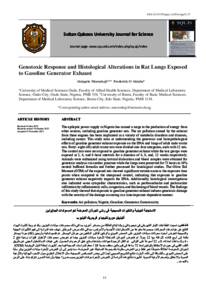Document
Genotoxic response and histological alterations in rat lungs exposed to gasoline generator exhaust.
Identifier
DOI:10.53539/squjs.vol29iss1pp15-27
Source
Sultan Qaboos University Journal for Scientific. v. 28, no. 1, p. 15-27
Contributors
Akinbo, Frederick O., Author
Other titles
الاستجابة الجينية والتغيرات النسيجية في رئتي الجرذان المعرضة لعوادم مولدات الجازولين.
Country
Oman.
City
Muscat.
Publisher
College of Science, Sultan Qaboos University.
Gregorian
2024-04-24
Language
English
English abstract
The epileptic power supply in Nigeria has caused a surge in the production of energy from other sources, including gasoline generator sets. The air pollution caused by the exhaust from these engines has been implicated in a variety of metabolic disorders and diseases, including cancer. This study aims at understanding the genotoxic and histopathological effects of gasoline generator exhaust exposure on the DNA and lungs of adult male wistar rats. Forty- eight (48) adult wistar rats were divided into four categories, each with 12 rats. The control rats were not exposed to gasoline generator exhaust while the test groups were exposed at 2, 4, and 8-hour intervals for a duration of 4, 8, and, 12 weeks respectively. Animals were euthanized using cervical dislocation and blood samples were obtained for genotoxic analysis via cardiac puncture while the lungs were preserved for 72 hours in 10% neutral buffered formalin and further processed for histological studies. The Olive Tail Moment (OTM) of the exposed rats showed significant variation across the exposure time points when compared to the unexposed control, indicating that exposure to gasoline generator exhaust negatively impacts the DNA. Additionally, histological investigations also indicated some cytopathic characteristics, such as peribronchiolar and perivascular infiltration by inflammatory cells, congestion, and thickening of blood vessels. The findings of this study showed that exposure to gasoline generator exhaust induces genotoxic damage with the severity of the damage occurring in a time/exposure-dependent manner.
ISSN
2414-536X
Arabic abstract
تسببت إمدادات الطاقة الصرعية في نيجيريا في زيادة إنتاج الطاقة من مصادر أخرى، بما في ذلك مجموعات مولدات البنزين. إن تلوث الهواء الناجم عن عوادم هذه المحركات قد تورط في مجموعة متنوعة من الاضطرابات والأمراض الأيضية، بما في ذلك السرطان. تهدف هذه الدراسة إلى فهم التأثيرات السمية الجينية والنسيجية المرضية للتعرض لعوادم مولد البنزين على الحمض النووي والرئتين لذكور فئران الوستار البالغة. تم تقسيم ثمانية وأربعين (48) فأرًا بالغًا إلى أربع فئات، تضم كل منها 12 فأرًا. لم يتم تعريض فئران المراقبة لعادم مولد البنزين بينما تم تعريض مجموعات الاختبار على فترات 2 و 4 و 8 ساعات لمدة 4 و 8 و 12 أسبوعًا على التوالي. تم القتل الرحيم للحيوانات باستخدام خلع عنق الرحم وتم الحصول على عينات الدم لتحليل السمية الجينية عن طريق ثقب القلب بينما تم الحفاظ على الرئتين لمدة 72 ساعة في 10٪ من الفورمالين المخزن المؤقت المحايد ومعالجتها لمزيد من الدراسات النسيجية. أظهرت لحظة ذيل الزيتون (OTM) للفئران المكشوفة تباينًا كبيرًا عبر نقاط وقت التعرض مقارنةً بالتحكم غير المكشوف، مما يشير إلى أن التعرض لعوادم مولد البنزين يؤثر سلبًا على الحمض النووي. بالإضافة إلى ذلك، أشارت التحقيقات النسيجية أيضًا إلى بعض خصائص الاعتلال الخلوي، مثل ارتشاح الخلايا الالتهابية حول القصبة وحول الأوعية الدموية، والاحتقان، وسماكة الأوعية الدموية. أظهرت نتائج هذه الدراسة أن التعرض لعادم مولد البنزين يؤدي إلى أضرار سمية جينية مع شدة الضرر الذي يحدث بطريقة تعتمد على الوقت/التعرض.
Category
Journal articles

